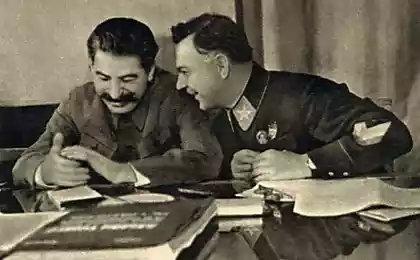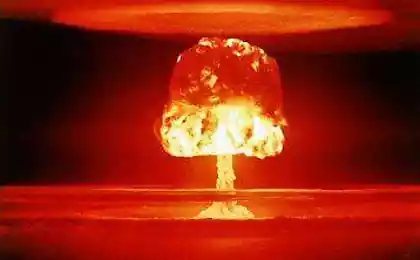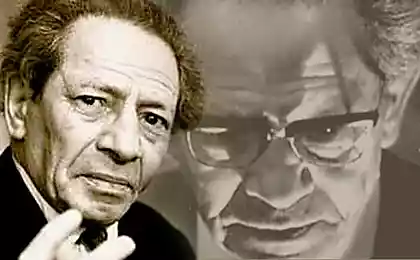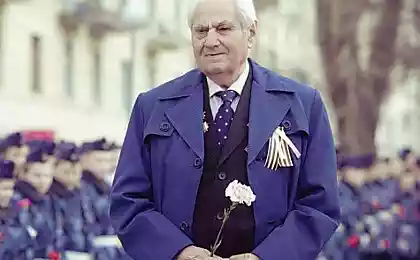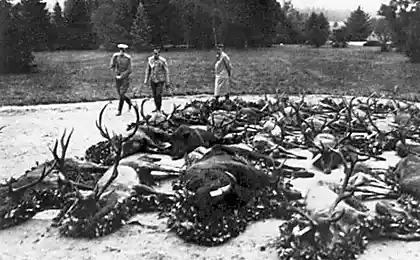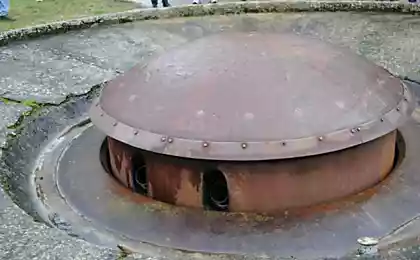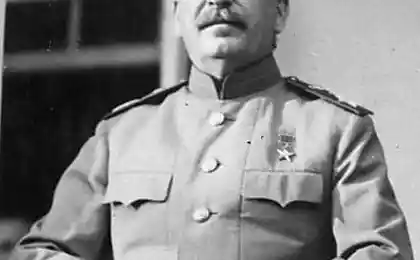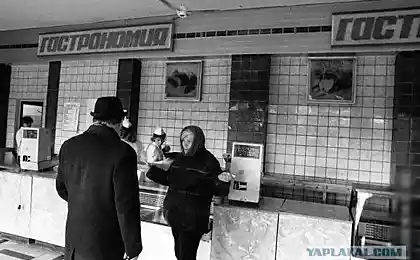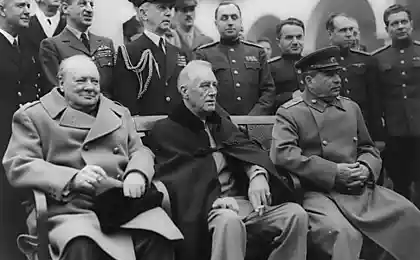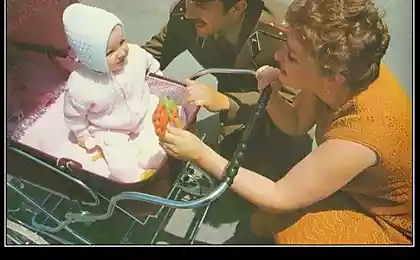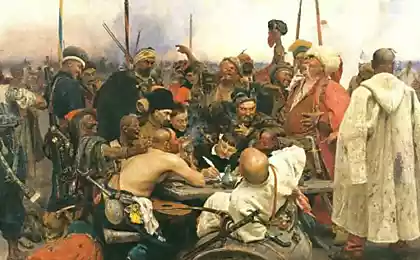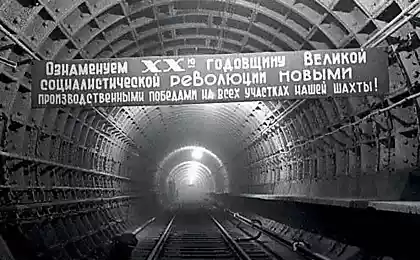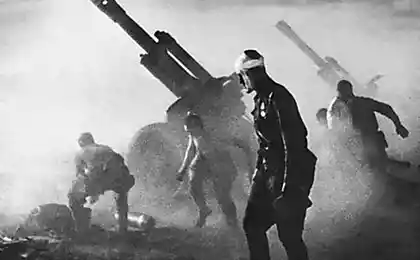648
Stalin paid veterans
70 years ago an order was issued on the premiums for each aircraft or a tank destroyed fascists
Via Mikhail Timoshenko, a retired colonel
There is a myth, stereotype: that the Red Army was fighting with the Nazis for the idea. Yet it is not only during World War II spurred Ote¬chestvennoy officers and soldiers. It was an effective system not only moral (Golden Star of the Hero, medals), but also material incentives distinguished men: for the destruction of enemy combat vehicles for the evacuation and repair his and a lot more of that. And all this had its price. "Father of all nations" understood that the ability of the Red Army to fight for the motherland good warm up not only propaganda and agitation, but also the ruble.
Bombed BERLIN - Get 2 THOUSAND
August 8, 1941, Stalin signed a decree on financial incentives pilots of the Baltic Fleet, who first bombed in Berlin "given by each member of the crew who took part in flight, in 2000 rubles. And continue to establish that each member of the crew, dropped bombs on Berlin, issue 2 thousand rubles. " The psychological effect of bombing the capital of the Reich in the grave was huge: let the enemy still comes, but we bombed Hitler's lair! Imagine people from black plate loudspeaker and triumphant voice Levitan: "... A group of our planes bombed military and industrial sites in Berlin» ...
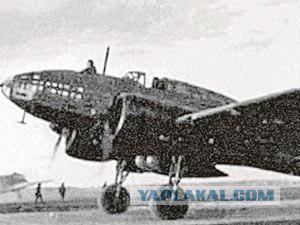
But after 11 days there was an order № 0299. It details the procedure for awarding the determined pilots of all types of aircraft. Include both cash payments and the presentation of an award (award or medal).
And in 1943, when our capacity has increased and the front moved westward, leveling covered. During the bombing of the capitals of the opponents (Berlin, Bucharest, Budapest and Helsinki) two thousand began receiving commander, navigator and borttehnik aircraft, other crew members - a thousand. Provision is made for the reduction and opponents of troop - the destruction caused by the collapse of a locomotive or tier: the pilot and co-driver - 750 rubles, the crew members - at 500.
HOW MUCH German battleship?
But the most expensive ships valued. For the sinking of a destroyer or submarine commander and navigator of our ship was owed to 10 000, and other members of the crew of 2,500 rubles. For transport - 3,000 rubles and 1,000 rubles respectively. During patrol - 2000 and 500 rubles. During lift - 1000 and 300. That is, the destroyer sunk cost five bombing of Berlin! The biggest prize went to the Hero of the Soviet Union Mikhail Borisov pilot - he torpedoed battleship "Silesia" - 10 000 rubles.
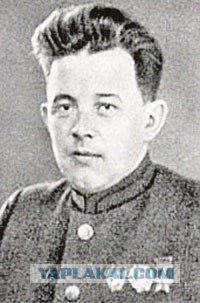
The tanks vdarit blanks
Do not forget about the Kremlin and the Marines: the USSR had several airborne corps hoped to use them to disrupt the blitzkrieg. We read in the order number 0329 dated August 29, 1941 .: "... for every part in the landing operation battle ... ... commanding staff receives a salary, ordinary and younger commanding structure - 500 rubles." But in that war, "winged infantry" used normally, and she had to get the money rarely.
And when used as intended, it also happens Uncle author of this material stepped over the side of lend-lease "Douglas" February 17, 1942 above the village of Desire. But the Germans shot down a plane with a corps commander General A. Levasheva. Control was lost and 7373 desantera went on the defensive. At uncle's share it had as much as 500 rubles. and all three bullets from the German MG-34.
Following are paying and repairmen number 0140 on the orders of February 25, 1942
Stalin was very responsive to changes in the situation on the front, the mood and needs of the troops. That inflames "Kharkov catastrophe" - the German break us so that we rolled down to Stalingrad and the North Caucasus. And there was an order number 0528 on July 1, 1942 on the establishment of anti-tank units. He defined "... for every destroyed tank commander and gunner guns - 500 rubles, the rest of the calculation - 200 rubles." Interestingly, in the draft order "fees" were twice as high. In addition, officers of anti-tank regiments and brigades received one and a half times their monetary salary, and the younger staff - a double. Do not envy: about them at the front used to say, "The trunk is long and life is short" - they had to stop the advances of German Panzerwaffe. It is in the midst of a barren steppe, deploying the move, without trenches and shelters. By all standards can take the gun dug in one tank, and then destroy it. A neokopannaya ... Nevertheless were heroes hit and five, and nine enemy tanks in one battle! And in June 1943 - the eve of the Battle of Kursk. June 24 issue of the decree number 0387, extension of payment for each destroyed tank in the gunners and infantry (including - antitank guns (PTR). What was in the purse comfrey?
I was there during the war, so to speak, the salary (in the military - allowance)? Yes, there was. Each serviceman and vary depending on the position (see. Table).
It seems to be the difference in money between superiors and subordinates big. But the system of incentive payments and allowances it largely smoothed. Thus, Art. Sergeant - At-2 pilot, Hero of the Soviet Union received: salary - 1200 rubles. per month + 25% and + 25% Guard front 10% of the departures. Total - 1920 rubles. More regiment commander. And this regiment commander toad is not tormented by envy, it does not require a rollback, and proud of his subordinates. With payments linked to many legends. One of them - say, the sniper to pay each of the enemy "head". And here and there. Sniper-corporal just gave sergeant's stripes and paid the first and second year of service 30 rubles. per month, and in the third year of service - 200 rubles. per month. A lot of? But how he lived the sniper?
Speaking of the infantry. It has long been estimated that the average life on the "front end" averaged 45 days, platoon - seven. What surprised - there is a regiment in the attack less than a day ...
In the army, there was a system Voyentorg and its vanguard - mobile shops that worked with parts of the front line. Their assortment least "postcards, envelopes, paper, pencils, tooth powder and toothbrushes, brushes and razor blades, combs, mirrors, pocket, thread, needles, hooks, buttonholes and buttons, pouches, tubes and cigarette holders, straps, and an asterisk logos. " In total there were more than 600 stores, and in the state of each number of the seller-peddler who could deliver the goods to the "front". There were send to the goods in high demand with a fixed price. Only in 1944 it was sold to 5 million. Parcels. RUBLE IN THE REAR
The average salary in the war years in the industry - 573 rubles. In the miners - 729 rubles., Metallurgists - 697 rub., The engineers - 1200 rubles., From farmers - up to 150 rubles. The prices on the market increased by 13 times against the prewar. Not that suit, you can not buy food. A bottle of vodka - 400 - 800 rubles. A loaf of bread cost 200 to 500 rubles., Potatoes - 90 rubles. per kg fat - 1500 rubles. per kg, grown tobacco - 10 rubles. glass.
It is easy to calculate that you could buy at a premium for the destroyed tank. So the money of those who were at the front, appeared to help their families in the rear. Officers sent to relatives cash certificate, on which they could receive part of their pay. A bonus money could help not only the families of officers, but also to the families of soldiers. POST-WAR PRICE
After the war, demobilized also paid. Ordinary - the annual salary for each year of service, sergeants and petty officers - from 300 to 900 rubles.
The officer has served a year - two months salary for two years - three, and so on. D. And for the restoration and repair of houses in areas of occupation allocated loans from 5000 to 10 000 rubles with a maturity of 5 to 10 years. Generals and senior officers with seniority over 25 years - loans 35 000 and 20 000 rubles. for individual and country construction. And the families of the victims, to them as they were paid? There were benefits and pensions. One-time benefits to wives of generals killed - 50 000 rub .; colonels, lieutenant colonels, majors - 10 000. With two disabled family it increased by half, with three disabled - in two. Stands out (save) apartment lettered rations, pensions to widows and children. Including the families of the generals, who were captured! But if there was no information about their collaboration with the enemy ...
Families of soldiers and junior commanders were paid as follows: on the one disabled - 100 rub., For two - 150 for three - 200. This is for the citizens. But in rural areas - only half of anything equal.
Surcharge for FEAT
After the war, according to the position of the medals of the USSR, approved by the CEC and the CPC of May 7, 1936, awarding the Order of the Soviet Union on a monthly basis due: for the Order of Lenin - 25 rubles., Of the Order of the Red Banner - 20 rub., For the Order of the Red Banner and Red Stars - 15 rub., for the Order "Badge of Honor" - 10 rubles. In addition, the order bearer had privileges: free travel on all modes of transport and discount on the rent. In 1948, to the great displeasure of the soldiers, payments and benefits canceled.
Partizan HUSBAND AND WIFE drips
With the guerrillas it was more difficult. The commander and commissar of the detachment were to receive not less than 750 rubles. Zamkomandira - 600 rub., The company commander, platoon or groups acting on their own - at least 500 rubles. But why Partisans Soviet rubles in German-occupied territory?
That's right, the money received for their relatives on the mainland. Or Partizan paid the amount due on his return from the squad. It is clear that paid only to those who on the list of the Central Staff of the partisan movement.
And how GERMANS?
Nothing like our system of payments of the Germans was not. Luftwaffe pilots of downed "Yaki" and "Lavochkin" awarded medals.
For Russian tanks lined steel only encourage since 1944. For our IS-2 relied extraordinary vacation. Sometimes - family food parcels "from the Führer."
Posted in [mergetime] 1312959073 [/ mergetime]
Thank you for attention!
Source:
Via Mikhail Timoshenko, a retired colonel
There is a myth, stereotype: that the Red Army was fighting with the Nazis for the idea. Yet it is not only during World War II spurred Ote¬chestvennoy officers and soldiers. It was an effective system not only moral (Golden Star of the Hero, medals), but also material incentives distinguished men: for the destruction of enemy combat vehicles for the evacuation and repair his and a lot more of that. And all this had its price. "Father of all nations" understood that the ability of the Red Army to fight for the motherland good warm up not only propaganda and agitation, but also the ruble.
Bombed BERLIN - Get 2 THOUSAND
August 8, 1941, Stalin signed a decree on financial incentives pilots of the Baltic Fleet, who first bombed in Berlin "given by each member of the crew who took part in flight, in 2000 rubles. And continue to establish that each member of the crew, dropped bombs on Berlin, issue 2 thousand rubles. " The psychological effect of bombing the capital of the Reich in the grave was huge: let the enemy still comes, but we bombed Hitler's lair! Imagine people from black plate loudspeaker and triumphant voice Levitan: "... A group of our planes bombed military and industrial sites in Berlin» ...

But after 11 days there was an order № 0299. It details the procedure for awarding the determined pilots of all types of aircraft. Include both cash payments and the presentation of an award (award or medal).
And in 1943, when our capacity has increased and the front moved westward, leveling covered. During the bombing of the capitals of the opponents (Berlin, Bucharest, Budapest and Helsinki) two thousand began receiving commander, navigator and borttehnik aircraft, other crew members - a thousand. Provision is made for the reduction and opponents of troop - the destruction caused by the collapse of a locomotive or tier: the pilot and co-driver - 750 rubles, the crew members - at 500.
HOW MUCH German battleship?
But the most expensive ships valued. For the sinking of a destroyer or submarine commander and navigator of our ship was owed to 10 000, and other members of the crew of 2,500 rubles. For transport - 3,000 rubles and 1,000 rubles respectively. During patrol - 2000 and 500 rubles. During lift - 1000 and 300. That is, the destroyer sunk cost five bombing of Berlin! The biggest prize went to the Hero of the Soviet Union Mikhail Borisov pilot - he torpedoed battleship "Silesia" - 10 000 rubles.

The tanks vdarit blanks
Do not forget about the Kremlin and the Marines: the USSR had several airborne corps hoped to use them to disrupt the blitzkrieg. We read in the order number 0329 dated August 29, 1941 .: "... for every part in the landing operation battle ... ... commanding staff receives a salary, ordinary and younger commanding structure - 500 rubles." But in that war, "winged infantry" used normally, and she had to get the money rarely.
And when used as intended, it also happens Uncle author of this material stepped over the side of lend-lease "Douglas" February 17, 1942 above the village of Desire. But the Germans shot down a plane with a corps commander General A. Levasheva. Control was lost and 7373 desantera went on the defensive. At uncle's share it had as much as 500 rubles. and all three bullets from the German MG-34.
Following are paying and repairmen number 0140 on the orders of February 25, 1942
Stalin was very responsive to changes in the situation on the front, the mood and needs of the troops. That inflames "Kharkov catastrophe" - the German break us so that we rolled down to Stalingrad and the North Caucasus. And there was an order number 0528 on July 1, 1942 on the establishment of anti-tank units. He defined "... for every destroyed tank commander and gunner guns - 500 rubles, the rest of the calculation - 200 rubles." Interestingly, in the draft order "fees" were twice as high. In addition, officers of anti-tank regiments and brigades received one and a half times their monetary salary, and the younger staff - a double. Do not envy: about them at the front used to say, "The trunk is long and life is short" - they had to stop the advances of German Panzerwaffe. It is in the midst of a barren steppe, deploying the move, without trenches and shelters. By all standards can take the gun dug in one tank, and then destroy it. A neokopannaya ... Nevertheless were heroes hit and five, and nine enemy tanks in one battle! And in June 1943 - the eve of the Battle of Kursk. June 24 issue of the decree number 0387, extension of payment for each destroyed tank in the gunners and infantry (including - antitank guns (PTR). What was in the purse comfrey?
I was there during the war, so to speak, the salary (in the military - allowance)? Yes, there was. Each serviceman and vary depending on the position (see. Table).
It seems to be the difference in money between superiors and subordinates big. But the system of incentive payments and allowances it largely smoothed. Thus, Art. Sergeant - At-2 pilot, Hero of the Soviet Union received: salary - 1200 rubles. per month + 25% and + 25% Guard front 10% of the departures. Total - 1920 rubles. More regiment commander. And this regiment commander toad is not tormented by envy, it does not require a rollback, and proud of his subordinates. With payments linked to many legends. One of them - say, the sniper to pay each of the enemy "head". And here and there. Sniper-corporal just gave sergeant's stripes and paid the first and second year of service 30 rubles. per month, and in the third year of service - 200 rubles. per month. A lot of? But how he lived the sniper?
Speaking of the infantry. It has long been estimated that the average life on the "front end" averaged 45 days, platoon - seven. What surprised - there is a regiment in the attack less than a day ...
In the army, there was a system Voyentorg and its vanguard - mobile shops that worked with parts of the front line. Their assortment least "postcards, envelopes, paper, pencils, tooth powder and toothbrushes, brushes and razor blades, combs, mirrors, pocket, thread, needles, hooks, buttonholes and buttons, pouches, tubes and cigarette holders, straps, and an asterisk logos. " In total there were more than 600 stores, and in the state of each number of the seller-peddler who could deliver the goods to the "front". There were send to the goods in high demand with a fixed price. Only in 1944 it was sold to 5 million. Parcels. RUBLE IN THE REAR
The average salary in the war years in the industry - 573 rubles. In the miners - 729 rubles., Metallurgists - 697 rub., The engineers - 1200 rubles., From farmers - up to 150 rubles. The prices on the market increased by 13 times against the prewar. Not that suit, you can not buy food. A bottle of vodka - 400 - 800 rubles. A loaf of bread cost 200 to 500 rubles., Potatoes - 90 rubles. per kg fat - 1500 rubles. per kg, grown tobacco - 10 rubles. glass.
It is easy to calculate that you could buy at a premium for the destroyed tank. So the money of those who were at the front, appeared to help their families in the rear. Officers sent to relatives cash certificate, on which they could receive part of their pay. A bonus money could help not only the families of officers, but also to the families of soldiers. POST-WAR PRICE
After the war, demobilized also paid. Ordinary - the annual salary for each year of service, sergeants and petty officers - from 300 to 900 rubles.
The officer has served a year - two months salary for two years - three, and so on. D. And for the restoration and repair of houses in areas of occupation allocated loans from 5000 to 10 000 rubles with a maturity of 5 to 10 years. Generals and senior officers with seniority over 25 years - loans 35 000 and 20 000 rubles. for individual and country construction. And the families of the victims, to them as they were paid? There were benefits and pensions. One-time benefits to wives of generals killed - 50 000 rub .; colonels, lieutenant colonels, majors - 10 000. With two disabled family it increased by half, with three disabled - in two. Stands out (save) apartment lettered rations, pensions to widows and children. Including the families of the generals, who were captured! But if there was no information about their collaboration with the enemy ...
Families of soldiers and junior commanders were paid as follows: on the one disabled - 100 rub., For two - 150 for three - 200. This is for the citizens. But in rural areas - only half of anything equal.
Surcharge for FEAT
After the war, according to the position of the medals of the USSR, approved by the CEC and the CPC of May 7, 1936, awarding the Order of the Soviet Union on a monthly basis due: for the Order of Lenin - 25 rubles., Of the Order of the Red Banner - 20 rub., For the Order of the Red Banner and Red Stars - 15 rub., for the Order "Badge of Honor" - 10 rubles. In addition, the order bearer had privileges: free travel on all modes of transport and discount on the rent. In 1948, to the great displeasure of the soldiers, payments and benefits canceled.
Partizan HUSBAND AND WIFE drips
With the guerrillas it was more difficult. The commander and commissar of the detachment were to receive not less than 750 rubles. Zamkomandira - 600 rub., The company commander, platoon or groups acting on their own - at least 500 rubles. But why Partisans Soviet rubles in German-occupied territory?
That's right, the money received for their relatives on the mainland. Or Partizan paid the amount due on his return from the squad. It is clear that paid only to those who on the list of the Central Staff of the partisan movement.
And how GERMANS?
Nothing like our system of payments of the Germans was not. Luftwaffe pilots of downed "Yaki" and "Lavochkin" awarded medals.
For Russian tanks lined steel only encourage since 1944. For our IS-2 relied extraordinary vacation. Sometimes - family food parcels "from the Führer."
Posted in [mergetime] 1312959073 [/ mergetime]
Thank you for attention!
Source:

